As we come down to the final stages of EURO 2024, games will potentially become even tighter, with teams seeking to avoid defeat instead of hunting for the win. Blocks may move deeper, become more compact, and be incredibly difficult to break down. This certainly won’t be the case in every game, but in the games where this is the case, set-pieces will be the key to unlocking the most stubborn defences.
You can attempt to be as stubborn as you like, but when a well-executed set piece is performed, there is no stopping it due to the unlimited potential set plays can offer. This article will focus on each team’s approach to defending set pieces and probe for the gaps in each setup
In this tactical analysis, we will look into the tactics behind the final eight teams at EURO 2024 and their approach to defending set plays, with an in-depth analysis of the weaknesses of each system. This set-piece analysis will examine how each setup could be exploited, and discuss the areas that the opposition should target.
Spain vs Germany
Spain’s fixture against Germany could arguably be a final as the two strongest sides of the Euros so far face each other in the opening quarter-final.
Due to Spain’s dominance, they have only had to defend seven corner kicks in the first four games, meaning no team has had the opportunity to test their defence from set plays consistently. However, it is clear to see some gaping holes in their setup, which have the potential to be exploited should an opponent identify these issues.
Spain use three zonal defenders spread across the width of the six-yard box, while one defender protects the near post. Four players are used to man-mark opponents inside the box. The issue with the positioning of the zonal defenders is the large spacing between each player. As the image below highlights, the near and far side zonal defenders are in line with both the near and far post, meaning that the central zonal defender is left alone to try to cover the entire width of the goal at the six-yard line. This means that should Germany increase the number of runs being made into the six-yard box, in the spaces in front and behind the central zonal defender, it is likely they will gain success. Runs into the black areas shown below will force the defender into committing to one of the two areas, which will open up the other area for a German player to attack freely.
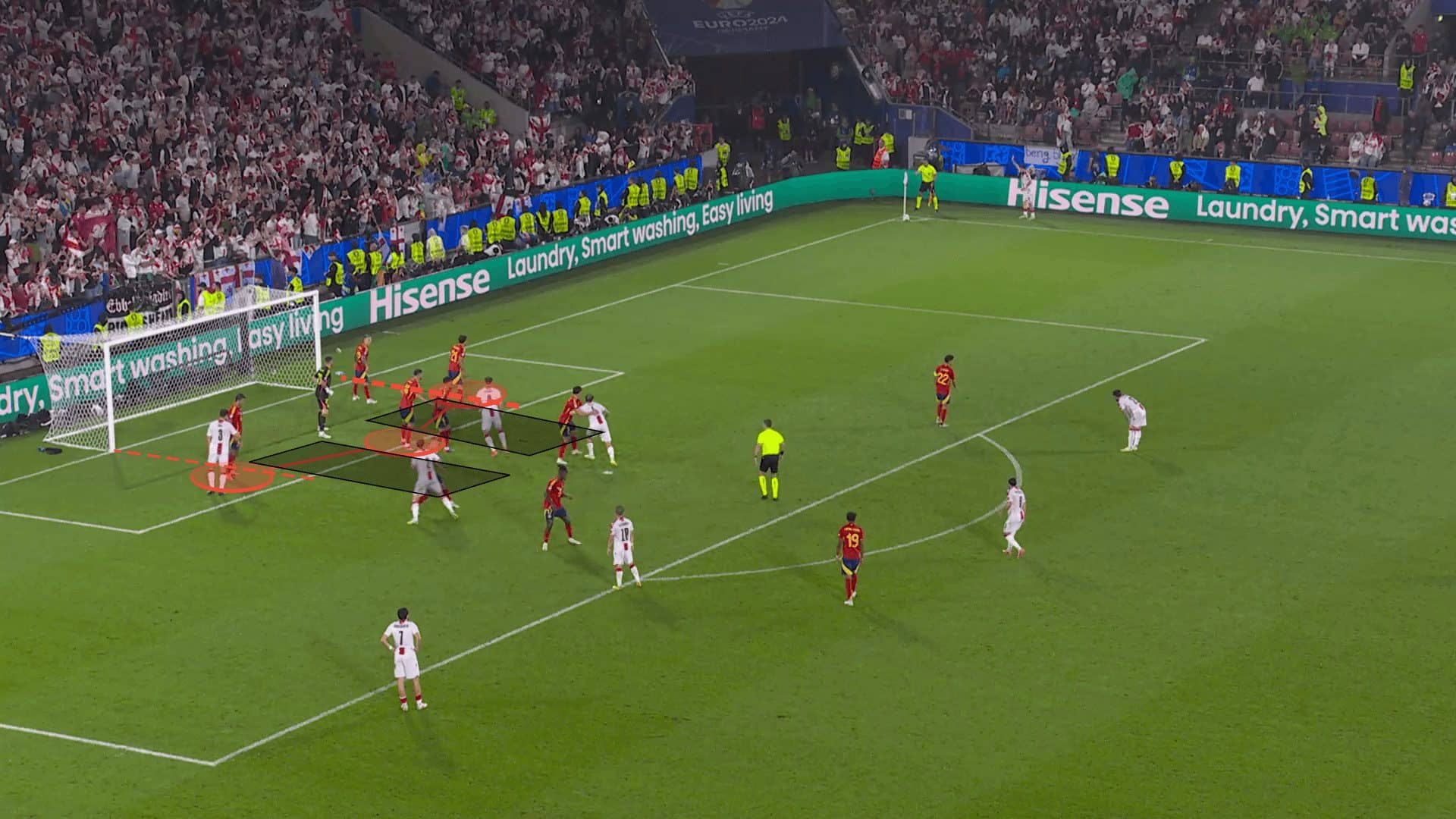
The man-marking unit will attempt to prevent the runners from entering the six-yard box, but due to Spain’s unit consisting of less physical players like Athletic Bilbao‘s Nico Williams, it will be possible for opponents to power their way through toward the goal or provide Germany with the opportunity to use the mismatch against a potential bigger attacker, where the ball can be crossed deeper directly to a German player who will likely win the aerial duel.
Upon examination of their defensive system and the likelihood of Germany forcing Spain to defend more than any other opponent yet winning more corner kicks, we will likely see Germany create multiple chances from corner kicks against the Spanish spacious zonal system.
On the other hand, Germany’s Achilles’ heel has already been identified in an earlier article, where the high line when defending free kicks, coupled with the late retreat back to cover the space, results in Germany often conceding chances from these situations. After multiple scares in the opening games, Germany persist with this system to prevent opponents from being able to reach space closer to goal, by trying to catch them offside and preventing them from making runs too early.
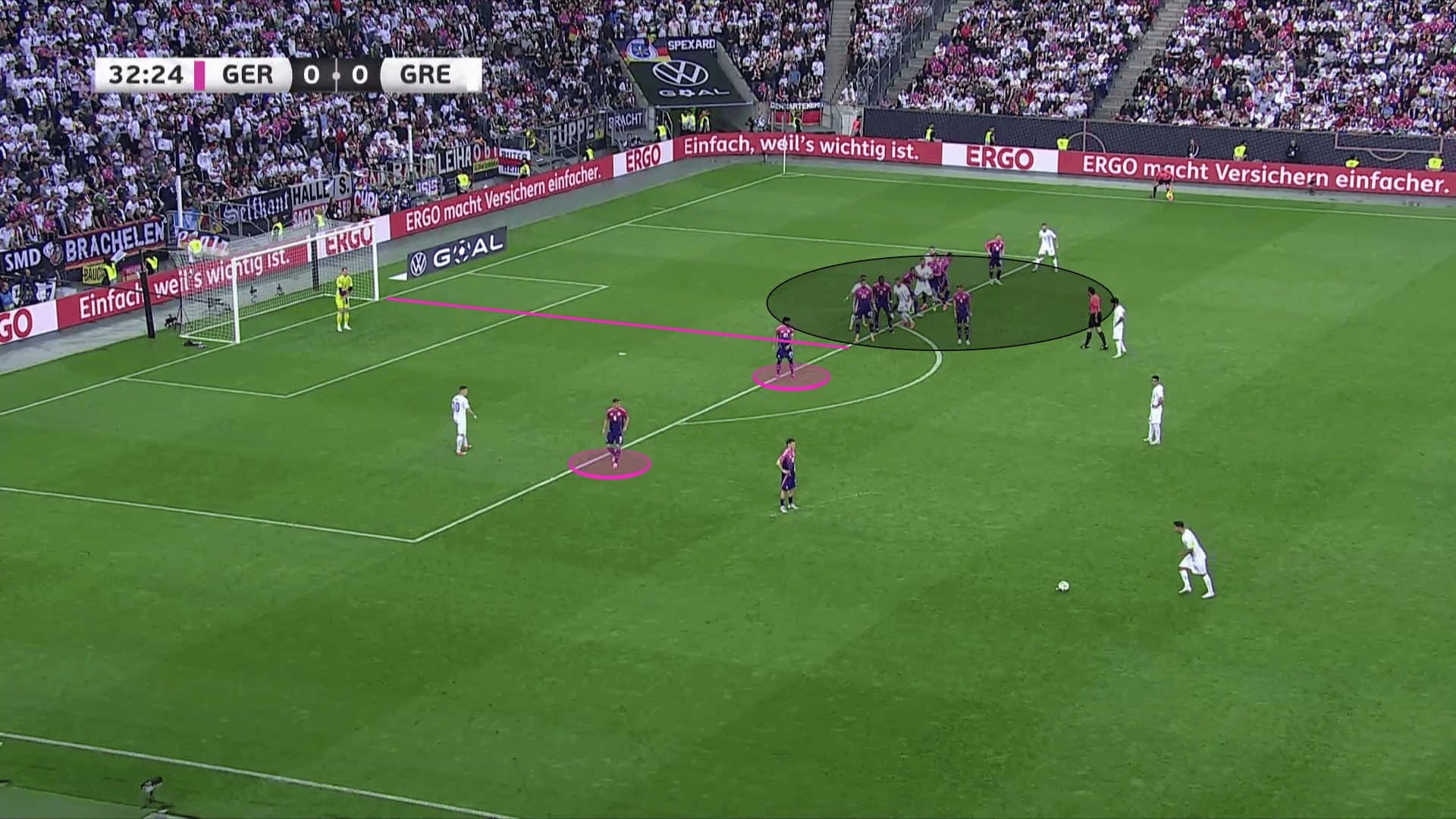
Portugal vs France
Portugal’s set-play defence has been strong in the opening four games. With their intention of condensing the six-yard box by using five players to protect the area, as well as the aerial dominance from Cristiano Ronaldo, Pepe, and Ruben Dias in the central areas, opponents will do well to win the aerial duels and make the first contact in these spaces.
However, by increasing the number of bodies in the six-yard box, Portugal’s defence of deeper spaces weakens. The man-marking in the image below consists of Machester United and Manchester City duo Bruno Fernandes and Bernardo Silva. Like with Spain, having a low number of players capable physically and in aerial duels can cause problems in deeper areas around the penalty spot. Opponents can and should target these spaces, where they can guarantee a mismatch with a physical player engaging in an aerial duel with Silva, where they can ensure the first contact at the penalty spot to either direct the ball goalwards following an outswinging delivery or perhaps flick the ball to either the front or back post for a second contact opportunity.

With France’s strong, physical midfield and towering central defenders, it would only make sense to use their aerial advantage to guarantee the first contact deep, especially with the lack of a set-piece specialist who can consistently whip the ball into dangerous spaces closer to goal.
While Portugal’s defence is heavily zonal, France lie on the opposite end of the spectrum. In the image below, France use a man-marking system, leaving only one defender to protect the zonal space at the six-yard line. Using an exclusively man-marking system provides opponents with the opportunity to drag each defender to wherever they’d like, giving the attacking side the chance to create their own space.
In the example below, Belgium drag France’s defenders away from the central space at the six-yard box, although the runs towards that space are poorly timed and attract each defender back to that area. Portugal have a blank canvas to work with and create a routine, where players will be able to create decoy runs to maximise the amount of space one target attacker will have to use in the aerial duel.
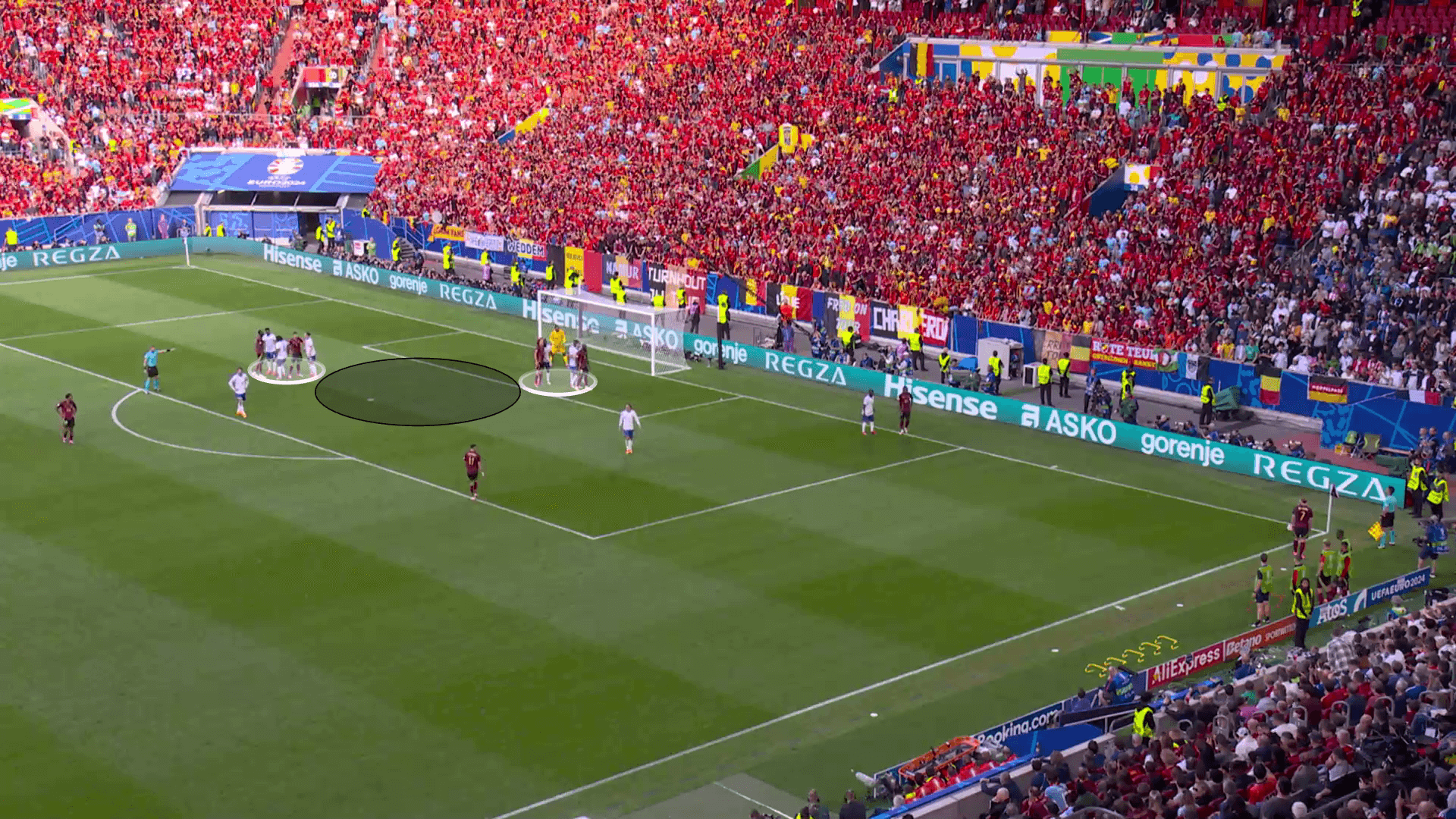
England vs Switzerland
England are also another side who haven’t had to face a large number of corner kicks, due to their higher possession values, but could potentially be vulnerable against a well-coordinated attack. Similarly to France, England focus on man-marking where each defender has the responsibility in preventing their assigned attacker from making the first contact. England use two zonal defenders to protect the near side of the six-yard box.
As mentioned earlier, man-marking allows the opposition to drag defenders away from certain spaces that they intend to attack. A clear area that is vulnerable for England is the space at the back post, where there is a lack of a zonal defender. If an attacker can outmanoeuvre his marker and arrive at that space, he will be free to tap in the ball to an empty net.
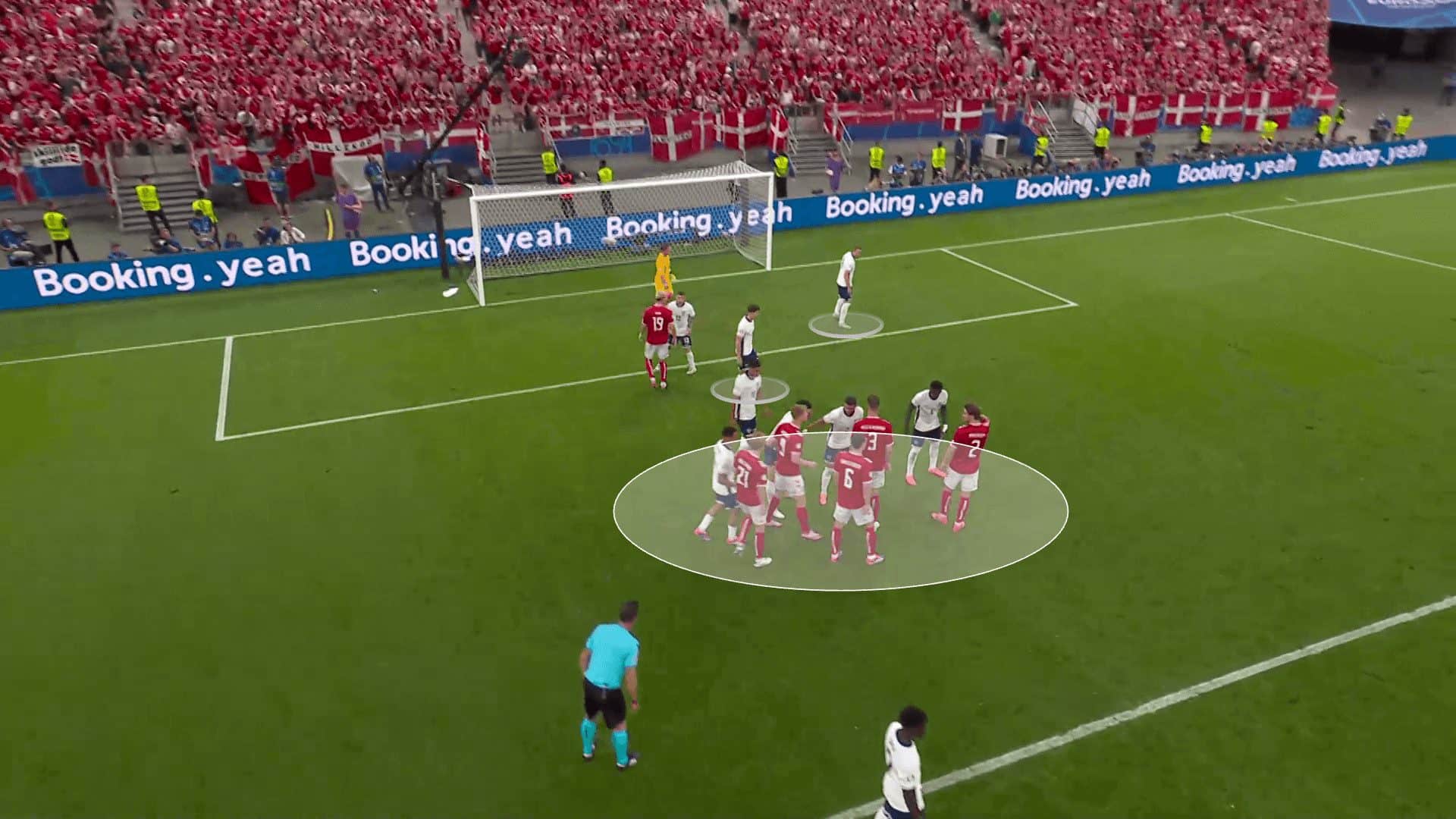
England are comfortable in leaving that space open due to the difficulty in delivering the ball into that area, with Pickford being able to claim any direct balls crossed there. However, the lack of zonal presence inside England’s system means they are vulnerable to crosses directed almost anywhere. Each man-marker is handed a lot of responsibility in ensuring the attacker doesn’t beat them to the ball. However, with the attacking unit starting in clusters in the examples given, traffic is created, and it becomes harder for defenders to track players in those congested areas.
Opponents will be able to cross the ball into the near edge of the six-yard box highlighted below, from where either an attempt on goal or a flick on to the back post space will be possible. If Switzerland identify these spaces, isolate target attackers, and execute their actions, they will cause England issues from every corner kick.
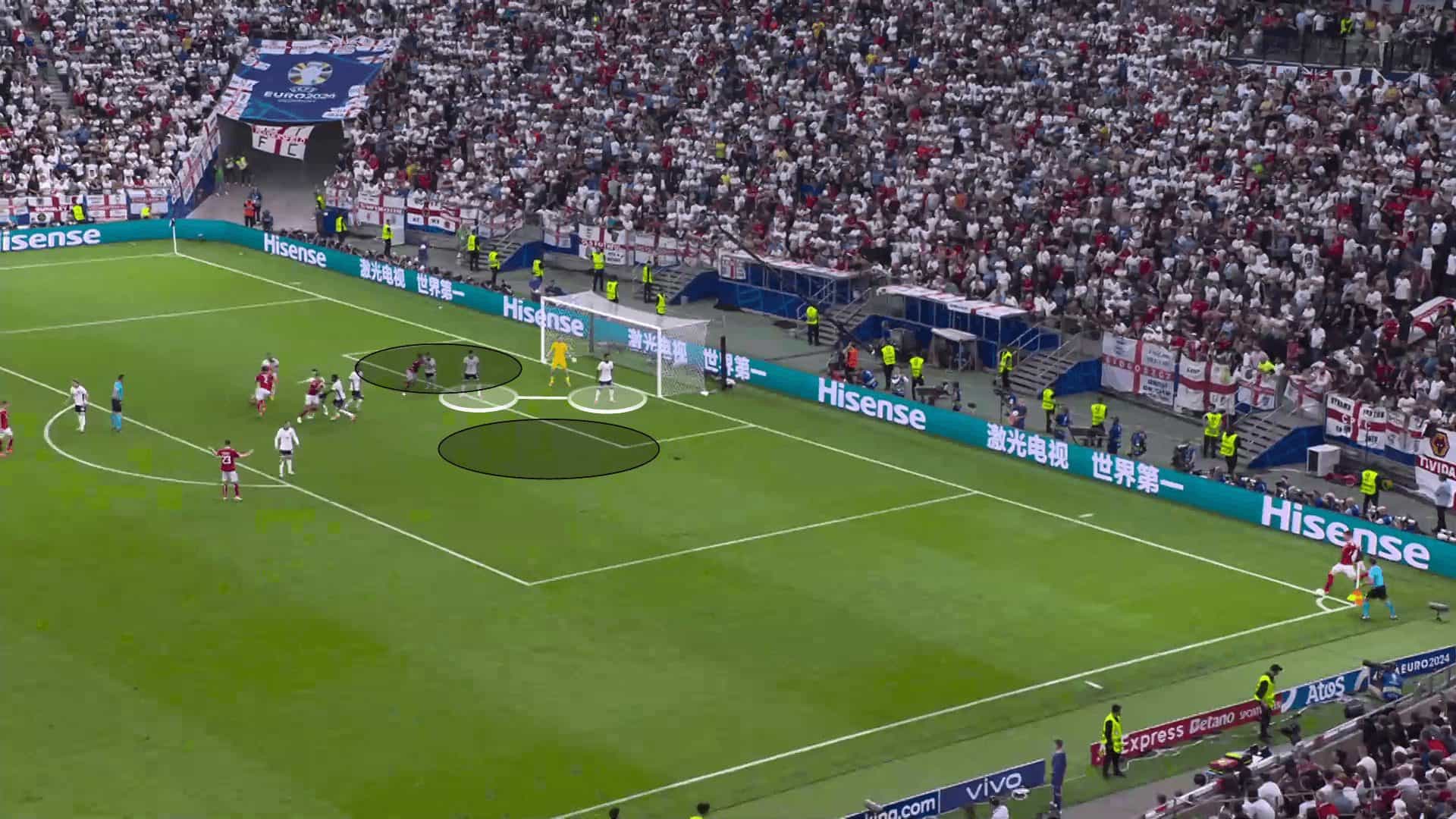
Switzerland themselves have issues that England will be able to attempt to exploit. Similarly to Portugal, Switzerland focus on a zonal defensive approach, leaving three players to prevent attackers from entering the six-yard box. Embolo can be seen ball-watching, allowing an attacker to run past him and attack the six-yard box with pace. This fault allows opponents to easily access the six-yard box and use their momentum to gain an advantage in aerial duels against the zonal defenders. It will be interesting to see if England adapt their routines to take advantage of the Swiss weakness, or if they continue to crowd the goal from inswinging corners.
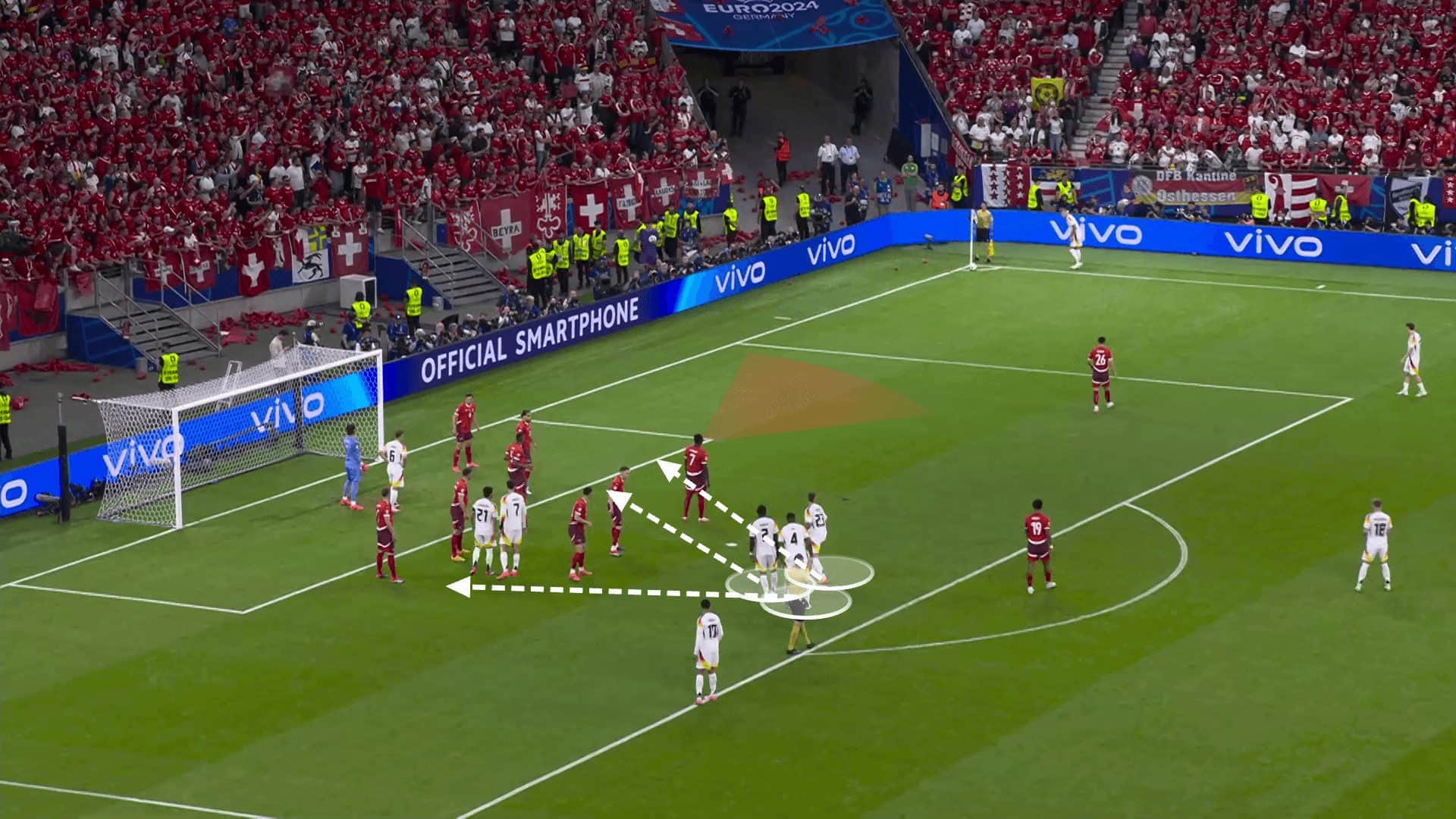
Something else that should be paid close attention to is Freuler’s movement when defending the near side of the six-yard box. His position starts deeper, at the front post, but his role is to prevent the near-sided flick-ons by following attackers into spaces at the front of the six-yard box. With Freuler’s movement becoming predictable, we know he will vacate the space at the front post. This space isn’t large, but if England can deliver the ball into the space shown below, it will almost certainly result in a goal if an attacker can attack the space before one of the static zonal defenders.
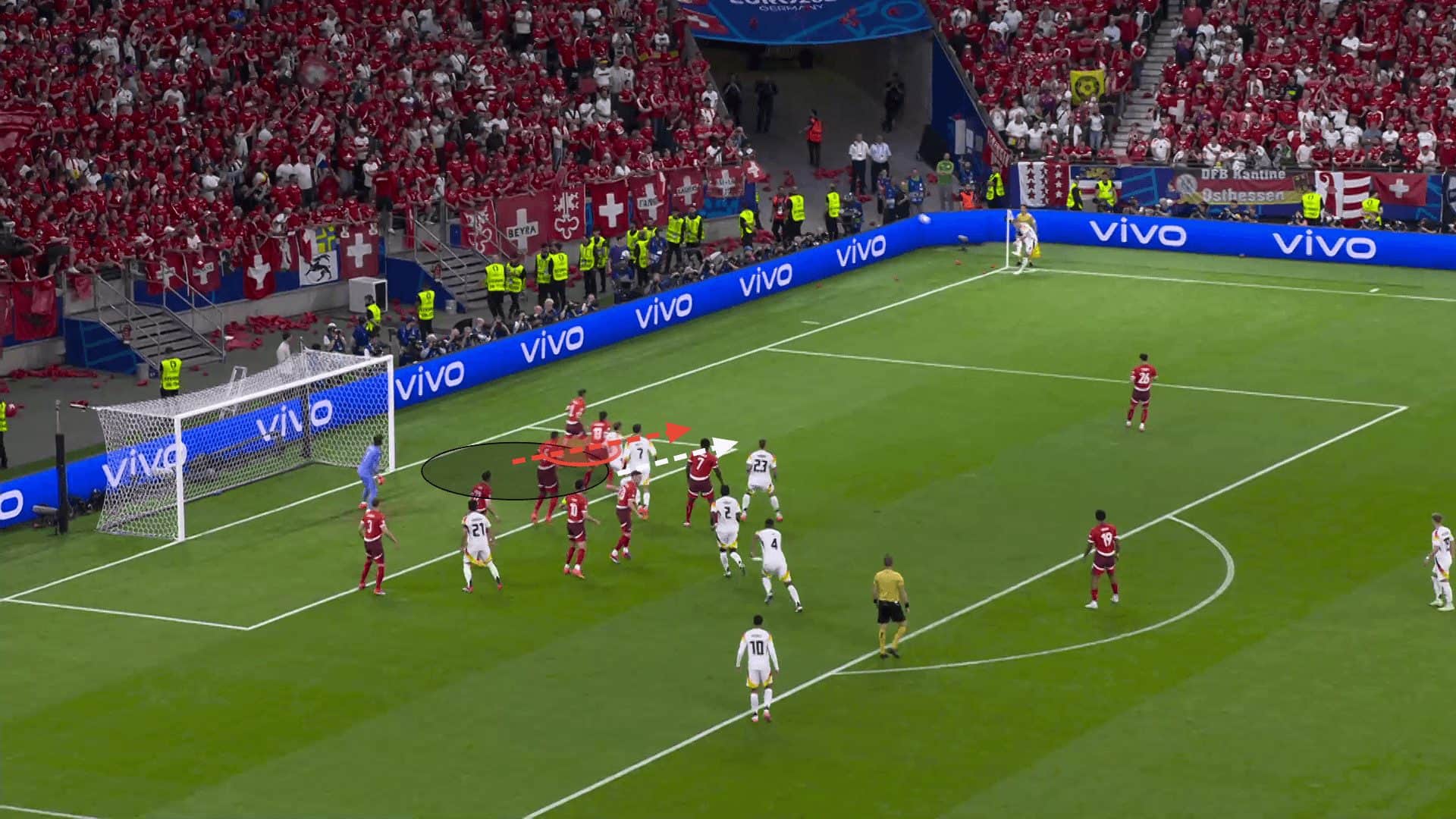
Netherlands vs Turkey
The Netherlands are another side that crowd the six-yard box with defensive numbers at the risk of leaving players deeper in more space. We can see the six-yard box is congested with six defenders, with an emphasis on preventing opponents from making the first contact at the near post area. Similarly to what was just described with Switzerland, the three blockers, whose role is to prevent opponents from entering the six-yard box, sometimes struggle with staying concentrated. Depay can be seen in the example below, letting attackers run in behind him while he is caught ball-watching.
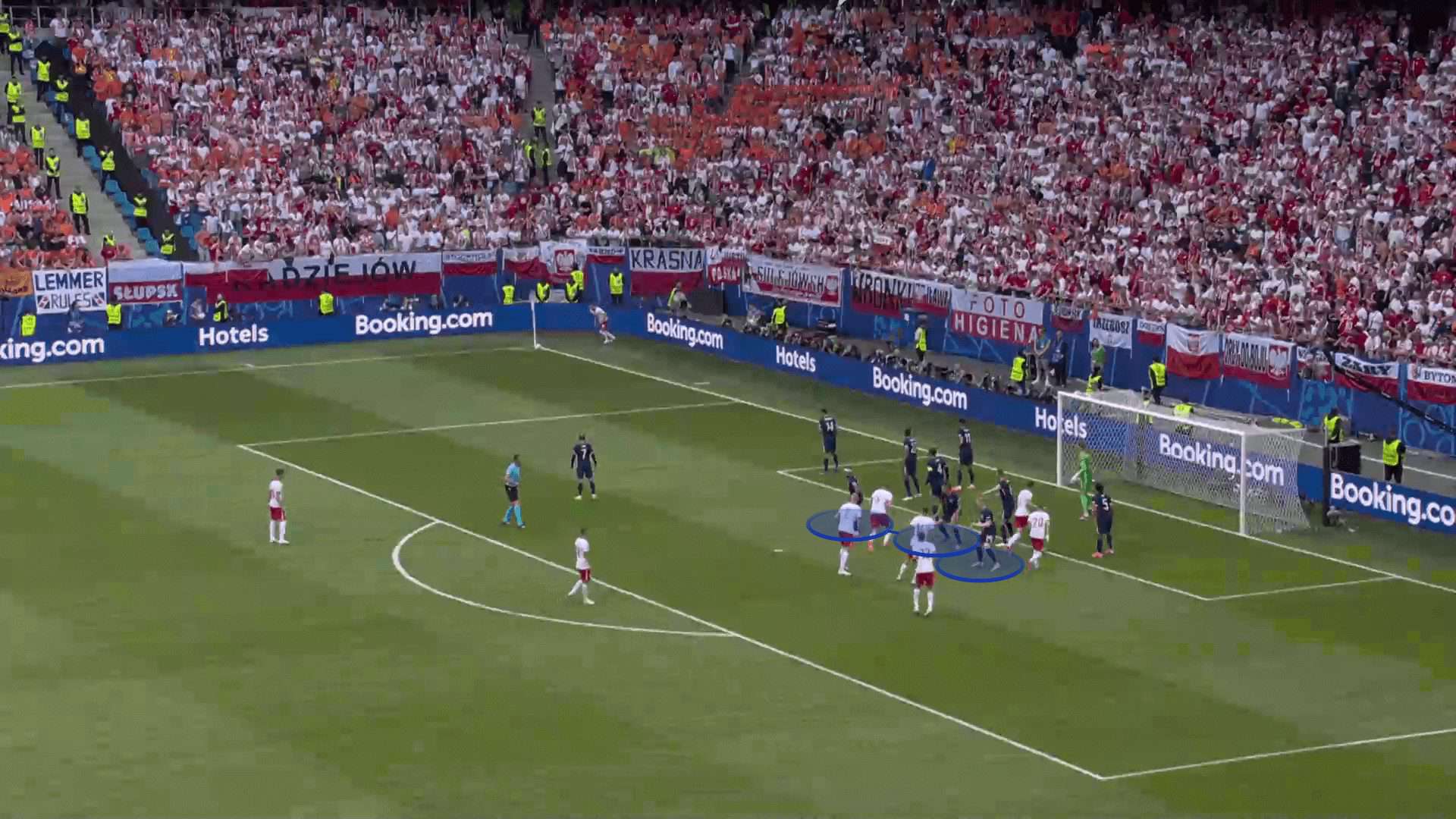
The Netherlands also use nine players to defend their box, leaving only one player to deal with short corners. This means that they are vulnerable to being outnumbered outside the box, making them vulnerable to short corners and second-phase opportunities. We can see, pictured below, that Romania play the short corner to the edge of the box, but with the longer distance the nearest player has to cover to put pressure on the ball, it gives the player on the edge of the box enough time to prepare himself to execute the cross to the highest standard.
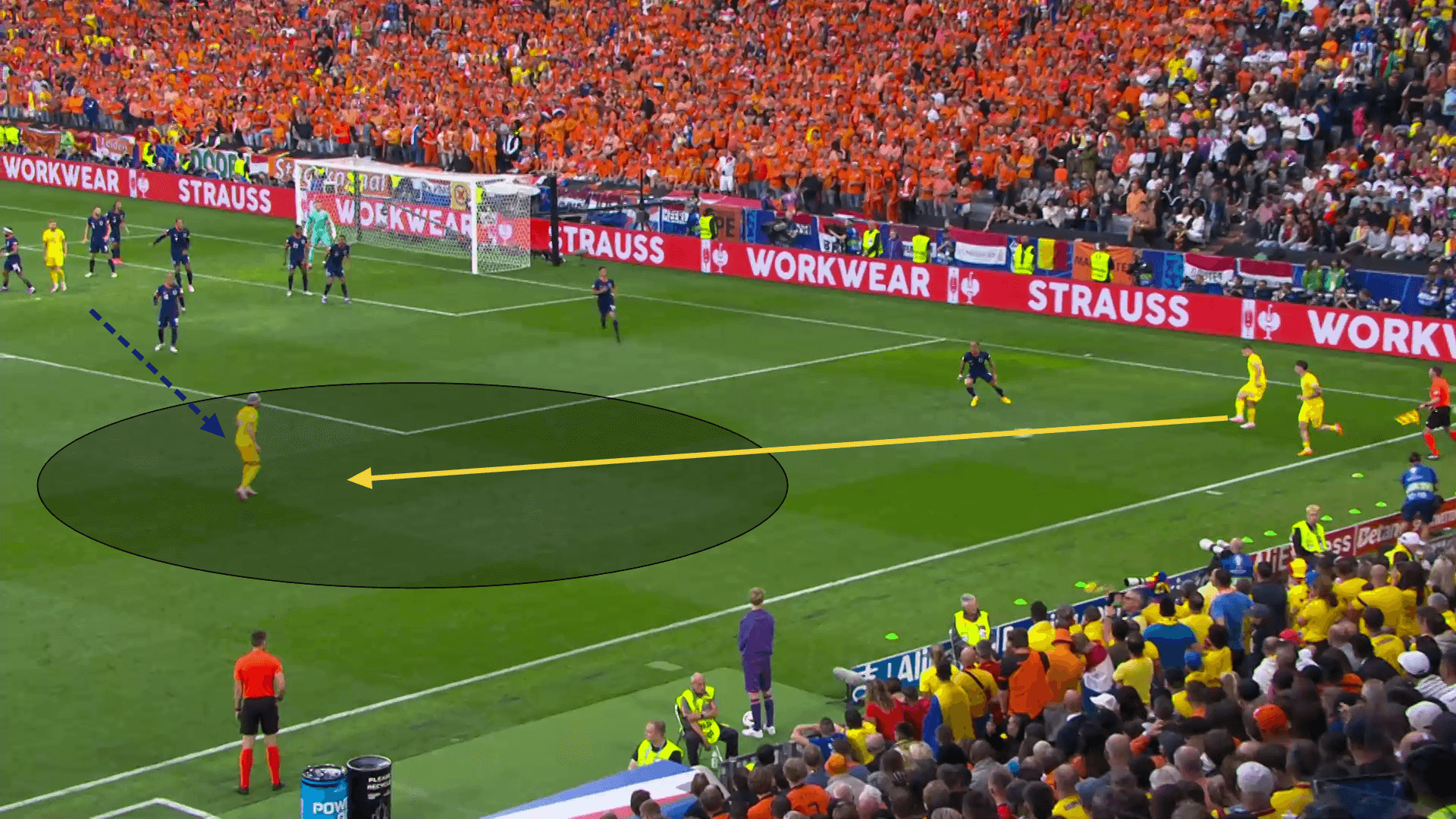
Turkey’s recent match is evidence of how important set plays can be to a team’s success, with all three goals being scored following corner kicks. In the goal Turkey conceded against Austria, it was clear to see how hard it can be for defenders to track attackers after the first contact is made.
Turkey’s deep zonal defence, with the zonal markers starting in line with the near post, gives opponents plenty of space to attack the ball and perform flick-ons, which they can direct toward the back post area. The deep positioning also gave Austria the opportunity to fizz the ball across the face of the goal, where a scramble at the back post meant the ball was only inches away from ending up in the back of the net.
Turkey’s heavy defensive presence inside their box also allows opponents to create chances from outside the box from short corners. Like the Netherlands, the defenders have a longer distance to cover, which gives the attacking side time to move the angle of the cross and deliver the ball without disruption.
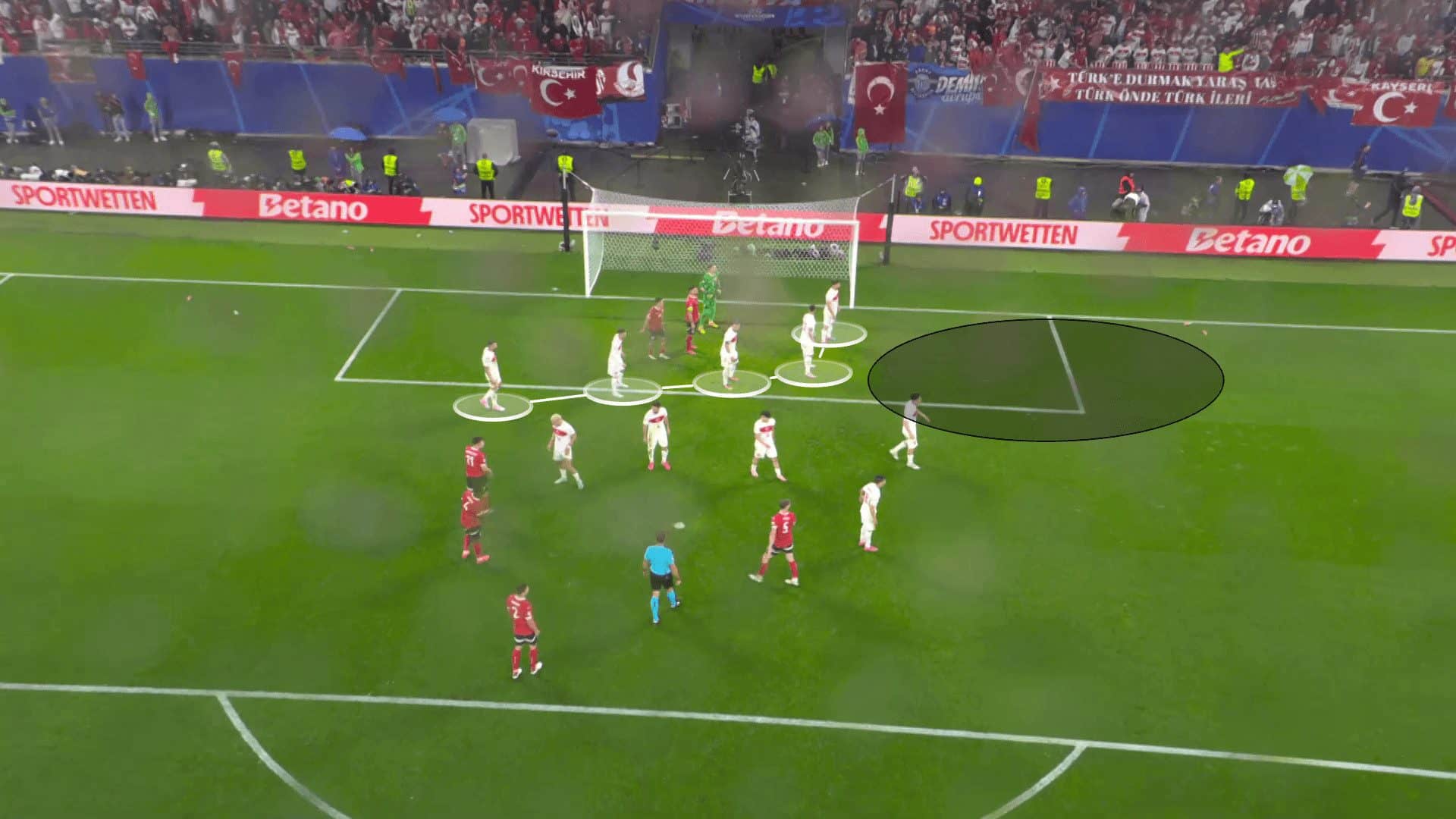
Conclusion
This tactical analysis shows how each team could be exploited from corner kicks in the upcoming quarter-finals. While some of the teams mentioned do have a strong defensive setup well prepared to deal with defending set plays, ultimately, the advantage lies with the attacking side, who can dictate what happens with the delivery of the ball and the movement of the attackers.
The limited time between fixtures doesn’t give teams the opportunity to change much from game to game, but one well-executed set play, which can be practised the day before the game, can be the difference between a semi-final spot and a disappointing exit.






Comments